- Author: Kathy Keatley Garvey
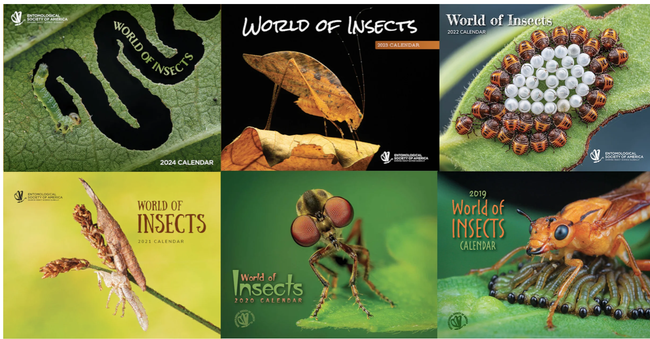
You'll see insects you've never seen before--and learn a little about them.
The cover image of the larva of the elm zigzag sawfly, Aproceros leucopoda (order Hymenoptera, family Argidae), native to Asia, is especially spectacular. It's the work of Christian Brockes of Germany.
"The elm zigzag sawfly is an east-Asian pest of elms (Ulmus spp), invasive in Europe since about 10 years ago and now also established in some North American regions," the ESA text relates. "The common name was inspired by the very distinctive patterns that their larvae leave on elm trees, while feeding. In large numbers, this species can critically damage elm populations. Often dozens of the tiny larvae--each only a few millimeters long--can be found on a single leaf, which they can skeletonize in a short period of time."
Scientists first detected this pest in the United States (Virginia) in 2021. Since 2022, it's been confirmed in four other states: Pennsylvania, North Carolina, Maryland and New York, according to research published in July 2023 in the Journal of Integrated Pest Management. The elm zigzag sawfly feeds exclusively on elms (Ulmus spp). It draws its name from the zizag-shaped pattern on the leaves as the larvae feed.
ESA prides itself on publishing world-class photography. Among the eight judges this year: Alex Wild, curator of entomology at the University of Texas and a doctoral alumnus from UC Davis. Wild studied with ant specialist Phil Ward, professor of entomology, UC Davis Department of Entomology and Nematology.
ESA issues a call for photos every January, and publishes the calendar every November. Of added interest, unselected images may appear on social media in the ESA's weekly "Arthropod Photo of the Week." Follow "Arthropod Photo of the Week" via the #arthropodPOTW hashtag on Twitter, Facebook, Instagram, and Mastodon.
We remember that an image of a hoverfly by UC Davis alumnus Alexander Nguyen appeared in the 2018 World of Insects Calendar. (See UC Davis of Entomology and Nematology website.) Judges chose his photo as one of the 12 winning images from a field of 560 entries submitted by 133 photographers from multiple continents. Nguyen captured the image at the UC Davis Stebbens Cold Canyon Reserve in April 2017, using his Canon 7D camera and a MPE 65-mm lens. Senior insect biosystematist Martin Hauser of the California Department of Food and Agriculture identified the hover fly as a male Platycheirus trichopus (Thomson, 1869).
What images are in the 2024 calendar? You'll see an ant tending treehopper nymphs, a chalcid wasp on Hemipteran eggs, stingless bees, a sunburst diving beetle, a Baltimore checkerspot butterfly, a Corsican owlfly, an ant-mimicking crab spider, a giant silk moth, an ambush bug preying on a bumble bee, a chestnut weevil, a poplar sphinx moth and an East Asian red damselfly. In addition, images that won honorable mentions share space on the calendar.
You can order the calendar here.
The 7000-member ESA, founded in 1889 and located in Annapolis, Md., is the world's largest entomological organization. It is affiliated with educational institutions, health agencies, private industry and government. Members are researchers, teachers, extension service personnel, administrators, marketing representatives, research technicians, consultants, students, pest management professionals, and hobbyists.
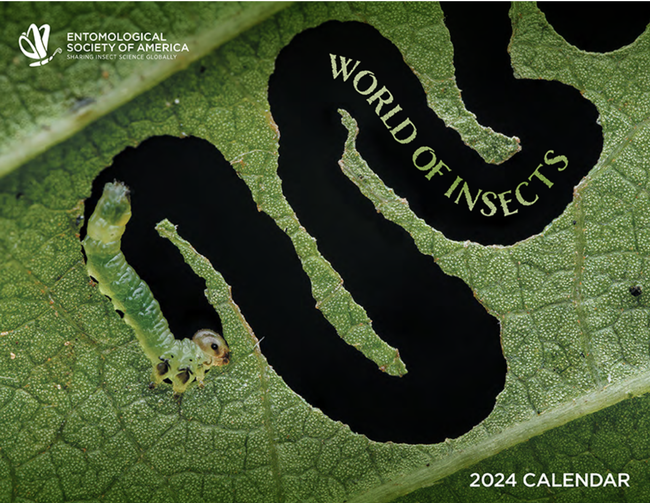
- Author: Kathy Keatley Garvey
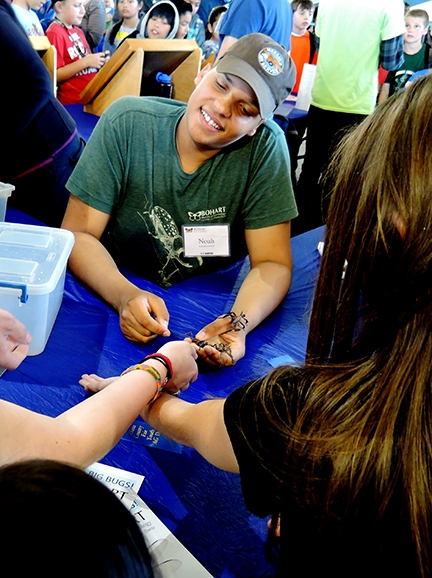
The 3000 third graders who attended the annual Youth Ag Day on Tuesday, March 14 on the Solano County Fairgrounds, Vallejo, learned their ABC's--of bugs--at the UC Davis Bohart Museum of Entomology's booth.
- A is for “awesome”
- B is for “bugs”
- C is for “cool”
Tabatha Yang, education and public outreach coordinator at the Bohart Museum and volunteers Alex Nguyen, Noah Crockette and Parras McGrath, kept busy from 9 a.m. to 1 p.m. as youngsters admired the specimens, ranging from butterflies to beetles; held Madagascar hissing cockroaches and walking sticks; and took more photos than you can shake a stick at.
Squeals of delight punctuated Exposition Hall. This was Bug World Unfolded!
With hands thrust up—“I wanna hold one!”—and heads, shoulders, hands and cameras crushed together, they took turns holding the insects. The consensus: “Hey, I found these really cool bugs that I've never seen before and I got to hold them and photograph them.”
Yang answered hundreds of questions as did the three Bohart volunteers: Nguyen, who holds a bachelor of science degree in entomology from UC Davis, and high school students Noah Crockette and Parras McGrath.
Crockette, who won the 2015 senior award from the Coleopterists Society, participated in the 10-day Bohart Bioblitz last summer in Belize.
At the Bohart booth, the third graders giggled as the walking sticks “tickled” them on their arms. In another corner, the Madagascar hissing cockroaches offered their obligatory hisses.
The annual Youth Ag Day is a collaborative effort of the Solano County Fair and agricultural related businesses, organizations, farmers, ranchers and other individuals to encourage Solano County third graders to experience agriculture first-hand, according to the fair officials. The third graders learn about cows, chickens, llamas, goats, honey bees, pollinators, and fruits and vegetables. The free event is designed to give the youngsters the opportunity to learn about food and fiber production from new perspectives, with a particular emphasis on the agricultural wealth of Solano County.
Bohart Museum
The Bohart Museum is located in Room 1124 of the Academic Surge Building, UC Davis campus. Directed by Lynn Kimsey, professor of entomology at UC Davis, it houses nearly 8 million insect specimens from all over the world. It also includes a live petting zoo, showcasing Madagascar hissing cockroaches, walking sticks and taranatulas, and a gift shop, featuring T-shirts, sweatshirts, books, jewelry, posters, insect-collecting equipment and insect-themed candy.
The Bohart Museum is open to the public from 9 a.m. to noon and 1 to 5 p.m. Mondays through Thursdays. It is closed to the public on Fridays, Saturdays and Sundays and on major holidays. Admission is free.
One of the major attractions are the Bohart Museum open houses, held on many weekends of the academic year. All are free and open to the public.
The next open house is from 1 to 4 p.m. Sunday, March 19. The theme: “Eggs to Wings: Backyard Butterfly Gardening.”
More information on the Bohart Museum is available by contacting (530) 752-0493 or bmuseum@ucdavis.edu. The website is http://bohart.ucdavis.edu/
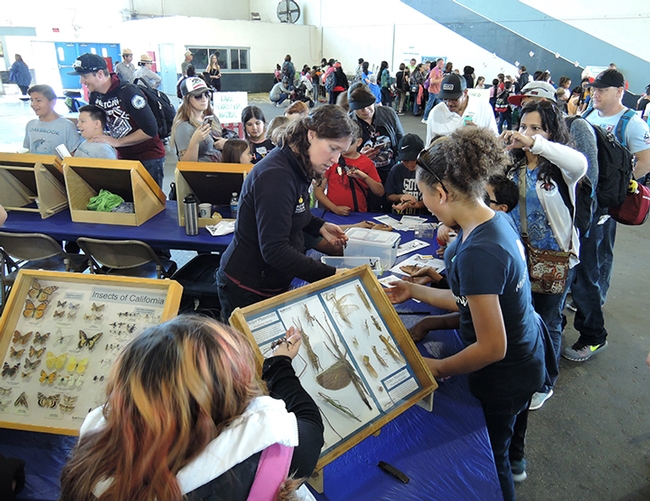
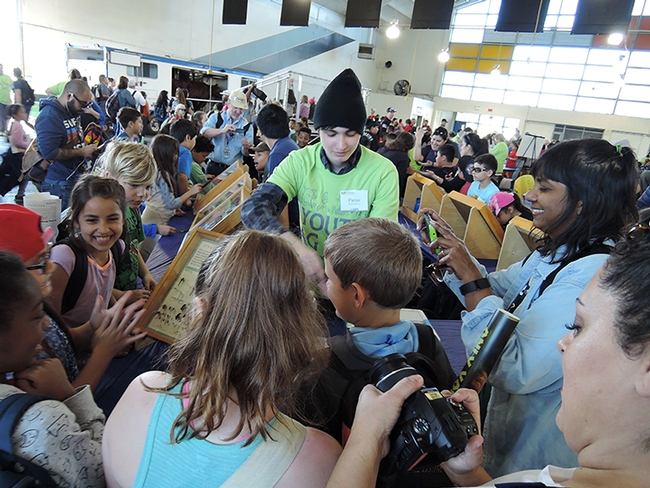
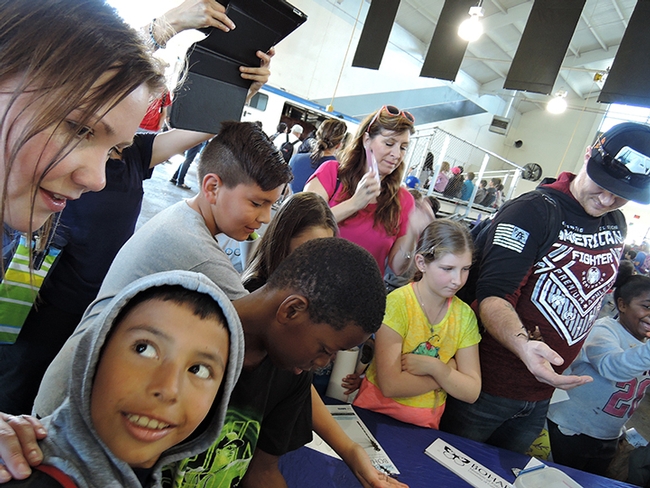
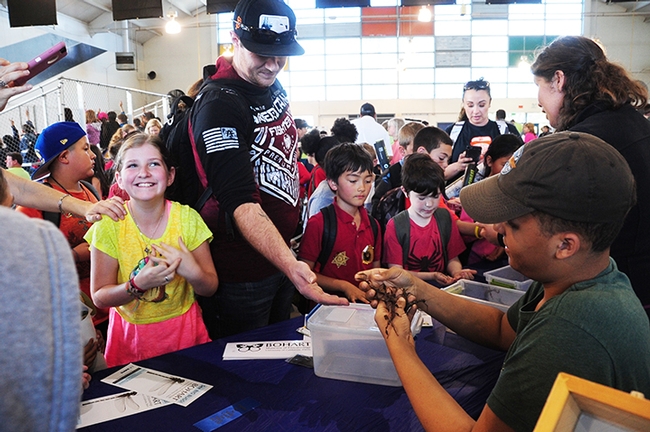
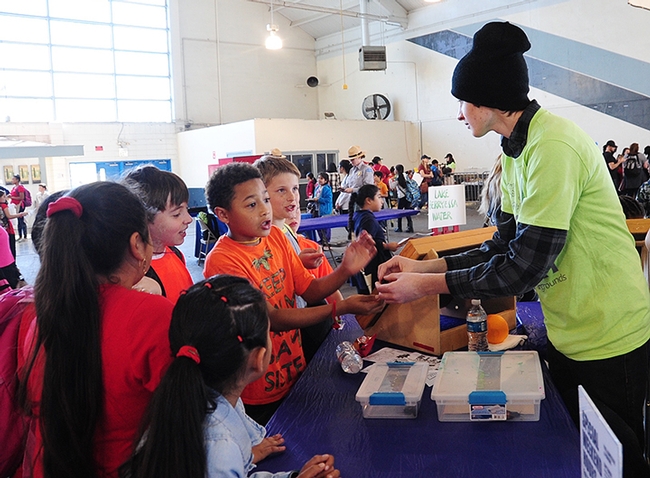
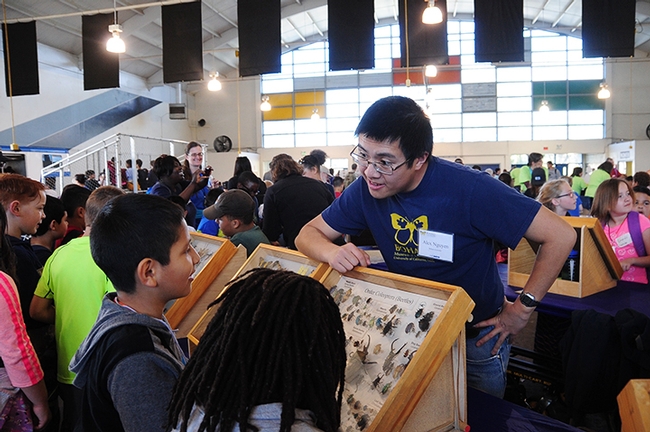
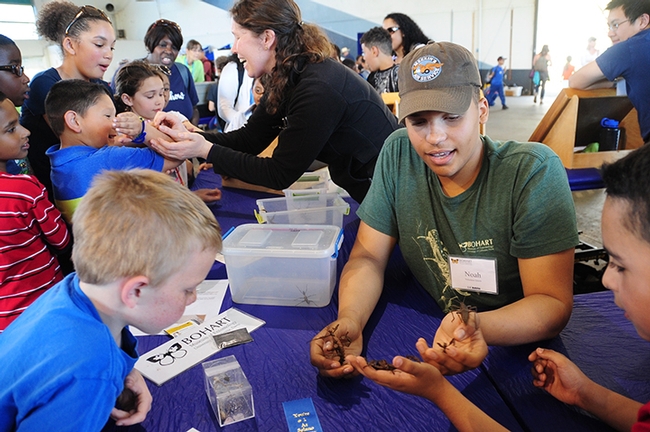
- Author: Kathy Keatley Garvey
You just can't beat those Halloween costumes at the Bohart Museum of Entomology's annual membership party.
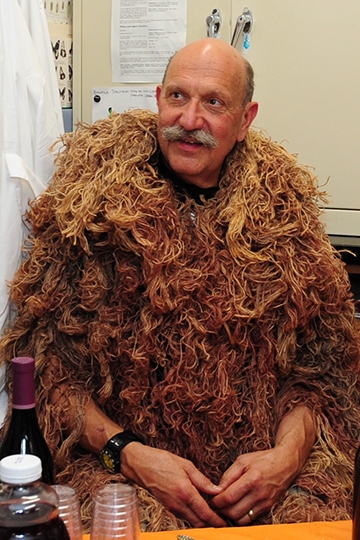
But have you ever thought of being a..drum roll..long-horned beetle? Of course, you have! Probably every Halloween, right?
Talk about creative!
UC Davis entomology undergraduate student Laurie Casebier crafted the cerambycidae beetle (long-horned beetle) costume. "I used my bike helmet and cut a hula hoop in half and attached the ends to my helmet to make the long antenna and used duct tape to make the familiar notched eyes," she said. "Then I cut out paper and my pseudotetramerous tarsi. I used a scarf as elytra. It was kind of modeled after the apple borer, but not really."
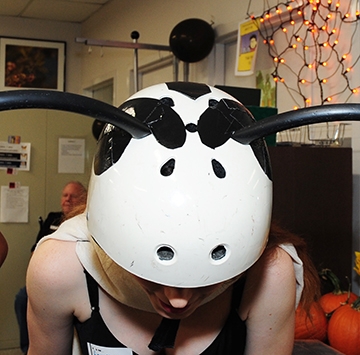
Forensic entomologist Bob Kimsey of the UC Davis Department of Entomology and Nematology faculty wore his favorite ghillie suit as he poured beverages for the crowd.
Then there were the look-alikes. Entomology student Maia Lundy, president of the UC Davis Entomology Club, dressed like her friend, entomology graduate Alex Nguyen ("Maia decided that it would be funny to look like me," he said)
and entomology graduate student Joel Hernandez and UC Davis alumnus Melissa Cruz arrived as lumberjacks,
And then were were the bees that buzzed and the butterflies that fluttered.
No one wore an orange T-shirt that proclaimed "This IS my Halloween costume."
That would..er...really bug entomologists.
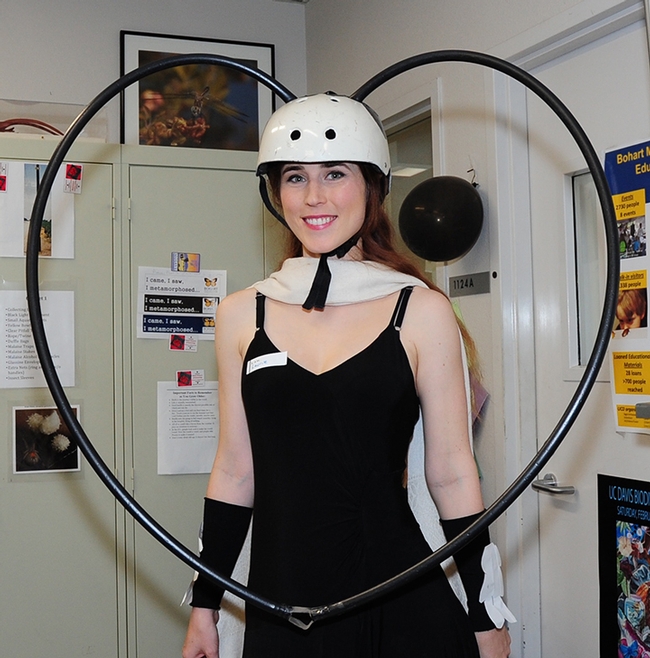
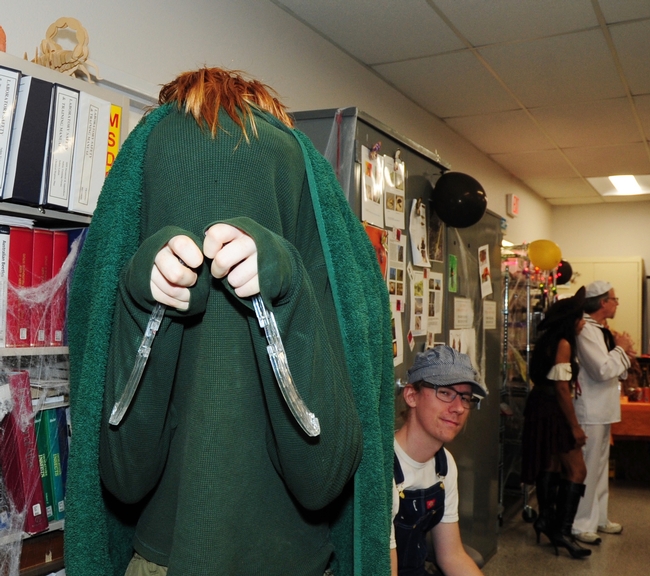
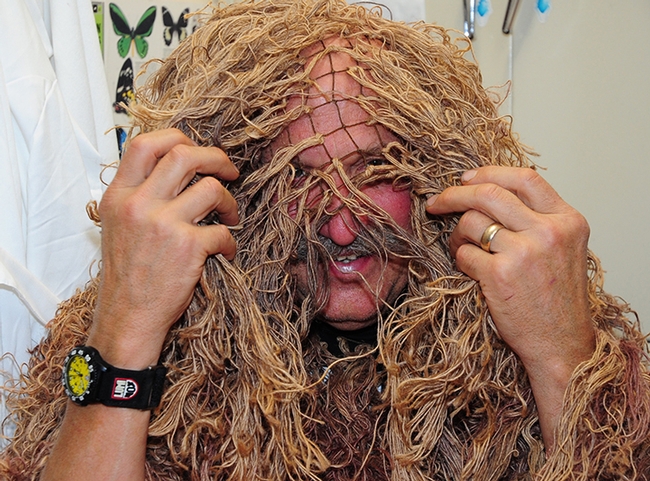

- Author: Kathy Keatley Garvey

Among the many activities at their recent "Snuggle Bugs" open house was a "mite/art station." Visitors were given a paper plate and invited to draw a mite, or other parasitic critter, and then attach the plate to an unsuspecting host.
Alex Nguyen, a third-year entomology student at UC Davis, managed to get most of the mites..er plates. Maybe it was because he was wearing a UC Davis Graduate Students' Association t-shirt lettered with "Entomology's Most Wanted." Or maybe the crowd saw him as a virtual parasitic pincushion.
"if you were a honey bee," the Bohart Museum sign at the mite table read, "this plate would be about the size of a varroa mite on you."
The Bohart Museum, directed by Lynn Kimsey, UC Davis professor of entomology, is the home of nearly eight million insect specimens, plus a live "petting zoo" that includes Madasgascar hissing cockroaches, walking sticks, rose-haired tarantula, millipedes and praying mantids. Located in Room 1124of the Academic Surge building on Crocker Lane, the insect museum is open to the public Monday through Thursday throughout the year (except on holidays).
Next event? On Saturday, Jan. 25, the Bohart staff and volunteers will travel to the InsectFest at the World of Wonders (WOW) Museum, Lodi, to showcase their insects.
The Bohart's next weekend "home" event is Saturday, Feb. 8, which is the annual UC Davis Biodiversity Day.
Six biological museums will be included in the campuswide event. You'll see the open collections of the Bohart Museum of Entomology, the Museum of Wildlife and Fish Biology, the Botanical Conservatory, the Center for Plant Diversity, the Anthropology Collections, and the Paleontology Collections.
The Biodiversity Day takes place from noon to 4 p.m. and is an opportunity to see "see carnivorous plants, touch fossils, learn about birds and hold insects," said Tabatha Yang, outreach and education coordinator at the Bohart.
Free and open to the public, it's a family friendly event. See the Bohart for more information and a map.
Insects? Plants? Fossils? Birds? "Bio Day" promises to be educational, informative and entertaining.



